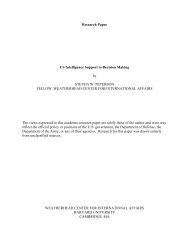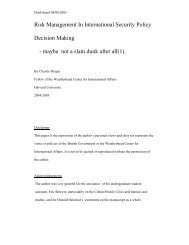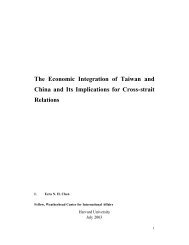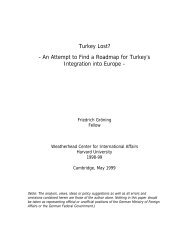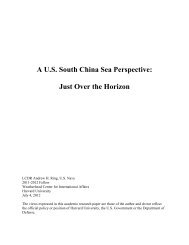A U.S. South China Sea Perspective: Just Over the Horizon
A U.S. South China Sea Perspective: Just Over the Horizon
A U.S. South China Sea Perspective: Just Over the Horizon
Create successful ePaper yourself
Turn your PDF publications into a flip-book with our unique Google optimized e-Paper software.
has been limited or no diplomatic and/or military contact during high-tension episodes, when<br />
clear communication could help diffuse misconceptions, mistrust, and anger.<br />
Admiral Samuel Locklear III stated in an interview in May 2012 that he hopes to<br />
streng<strong>the</strong>n military-to-military relations with <strong>China</strong> through better communication: “<strong>China</strong> is an<br />
emerging power with many significant decisions to make and <strong>the</strong> United States would like to<br />
play a role in helping influence those decisions in a way that promotes a secure global<br />
environment. One way to build trust and confidence between those militaries is through military-<br />
to-military operations.” 72 The U.S. Navy should take <strong>the</strong> lead to engage <strong>the</strong> Chinese military in<br />
meaningful participation in as many exercises as possible throughout <strong>the</strong> Pacific. Not only would<br />
this improve <strong>the</strong> U.S.-<strong>China</strong> relationship but also streng<strong>the</strong>n <strong>China</strong>’s military-to-military<br />
relations with ASEAN members. <strong>China</strong> has demonstrated it is prepared for such measures<br />
through conducting its first joint naval exercise with Russia in April 2012. 73 <strong>China</strong> sent two<br />
submarines and sixteen warships for <strong>the</strong> six days of exercises in <strong>the</strong> Yellow <strong>Sea</strong>. The Russo-<br />
Chinese exercises coincided with U.S.-Philippine joint war games near <strong>the</strong> <strong>South</strong> <strong>China</strong> <strong>Sea</strong>,<br />
which also involved Australia, Japan and <strong>South</strong> Korea.<br />
Engaging <strong>China</strong> requires more than simply arranging for high-level exchanges,<br />
occasional port visits and exercises. Military-to-military relations are <strong>the</strong> most effective when<br />
<strong>the</strong>y incorporate <strong>the</strong> full spectrum of rank. Opportunities should be extended for Chinese<br />
midshipman to attend <strong>the</strong> U.S. Naval Academy and for Chinese junior officers to attend <strong>the</strong> U.S.<br />
Naval War College and Naval Postgraduate School. Today, many U.S. Naval Academy and<br />
Naval Reserve Officer Training Corps midshipmen have an opportunity to study in <strong>China</strong> as part<br />
of <strong>the</strong>ir academic curriculum. Why not continue this exposure by negotiating for U.S. naval<br />
officers to attend <strong>China</strong>’s professional military schools and vice versa? The U.S. Military<br />
44



